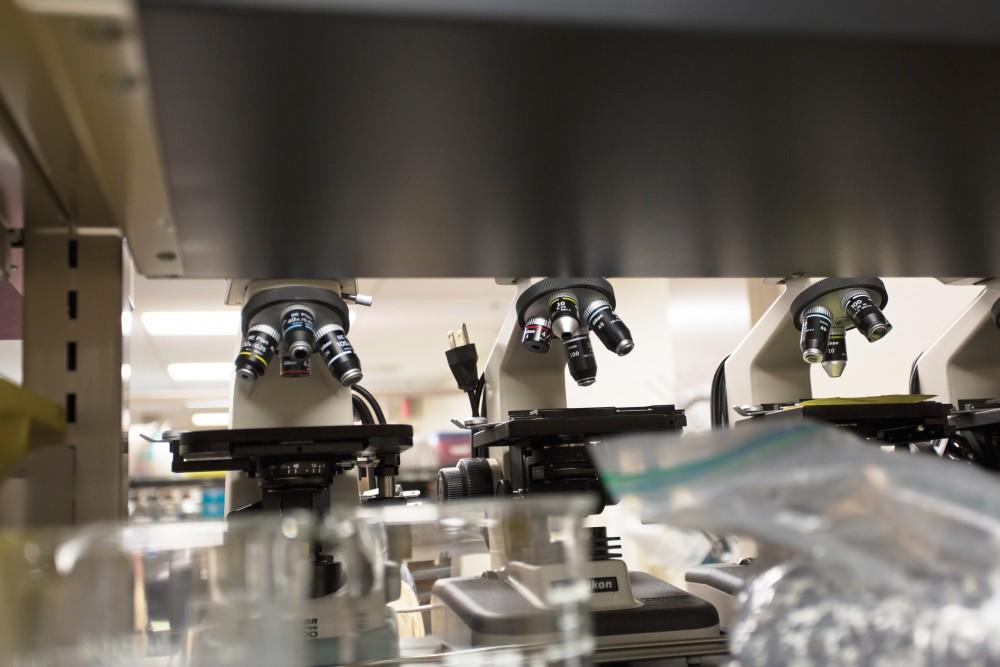GVSU awarded $500K grant to test potential cure for Parkinson’s disease

GVL / Kevin Sielaff Grand Valley celebrates the P. Douglas Kindschi Hall of Science with a dedication ceremony Friday, August 28th, 2015. The dedication recognized both Grand Valley and state officials that made the realization of this building possible.
Jan 18, 2018
Recently, a team of researchers from Grand Valley State University, Rush University and the Van Andel Research Institute received a $500,000 grant to test a possible cure for Parkinson’s disease (PD). The grant was provided by the National Institute of Neurological Disorders and Stroke, part of the National Institutes of Health (NIH).
PD is a neurodegenerative disorder that affects predominately dopamine-producing neurons in a specific area of the brain, causing them to drop and subsequently affecting movement over time, according to the Parkinson’s Foundation website. PD is a very prevalent issue, as about 1 million Americans live with the disease, and approximately 60,000 Americans are diagnosed with it each year, per the same source.
Merritt DeLano-Taylor, associate professor of biomedical sciences at GVSU, will serve as one of the three researchers who will be testing for a cure. He will be joined by Van Andel Research Institute’s Patrik Brundin and Rush University’s Jeffrey Kordower.
DeLano-Taylor has been involved in an ongoing research project centered around PD, testing if the introduction of a modified protein, known as PM-Nato3, will protect dopamine neurons from the harmfulness of the disease. The technology that will be used in the research was developed by GVSU alumni Jordan Straight, Nicholas Huisingh, Douglas Peterson and Daniel Doyle while they were undergraduate students.
“The grant is testing an agent that we developed in my lab (PM-Nato3) that helps cells make a neuroprotective series of factors, and these factors have been shown to be helpful for protecting neurons against cell death in Parkinson’s-like conditions,” DeLano-Taylor explained.
The associate professor will be assisted in his research by two current students in his lab: Melina Frantzeskakis, a junior at GVSU, and Maxwell Okros, a freshman. Dayne Martinez, a former GVSU student who is now graduated, will also be involved in the project.
“So, what we’re doing is we’re collaborating with people who have done a lot of those experiments in Parkinson’s models, in cells and in animal models, and seeing if our agent really can do something to help protect those neurons from getting damaged or killed by the Parkinsonian conditions,” DeLano-Taylor said.
The research the grant will fund started off as a Student Summer Scholars project, according to DeLano-Taylor.
“Those results are what made us think, ‘Oh, these are really interesting,’” DeLano-Taylor said. “So this grant, … what happened was basically this area, and West Michigan, has a lot of really good Parkinson’s people in it, or people who are studying Parkinson’s, and so we wanted to see if any of them are interested in our work. … It just turned into a really good conversation, and then we were like, ‘We should write a grant and see if we can get the support we need for it.’”
Frantzeskakis, who is currently studying cell and molecular biology, said she will be responsible for designing protocols to reach goals laid out in the team’s research; most of her work has been with the creation and screening of the PM-Nato3 mutants that will be used in the research.
“The previous research our lab has been conducting has been utilizing our basic Helix-Loop-Helix transcription factor Nato3 as a means to drive dopamine neurogenesis (neurons being generated in the brain),” Frantzeskakis said via email. “This means that we were only looking at its ability to up-regulate (increase a response in) genes that indicated dopamine neurons were being produced. The impact of this research meant that we could potentially utilize this as a regenerative therapy down the line for people who are already suffering from Parkinson’s disease.
“However, in doing this work, our lab identified PM-Nato3 had the ability to up-regulate the gene En1, which in other publications this gene is indicated to have neuro-protective effects in dopamine neurons. This means that with this grant our research is going to begin also looking at PM-Nato3 in the context of the prevention of Parkinson’s disease. This shift could mean that there is a potential for us to improve the lives of those who suffer from this devastating disease before it occurs.”
DeLano-Taylor said the NIH was “very excited” about the expertise of the team of researchers, as well as the support that GVSU has for innovation for its students being involved in projects and faculty being able to pursue “high-risk projects.”
“The main goal is to determine if there are ways that we can help improve therapeutics for Parkinson’s disease,” DeLano-Taylor said. “The way we approach it is … how can we use what we understand about how the cells work normally and see if we can kind of hack it if you will.”
Not only does this research have the potential to impact peoples’ lives significantly around the world, but it also has an impact on the students involved by engaging them in relevant, important work.
“I have learned so much more from this lab than I ever believed I could in my undergraduate career,” Frantzeskakis said. “Professor Taylor has given me the ability to improve my prospective future and has been very involved in my personal growth despite being an incredibly busy faculty member at Grand Valley.
“All of these aspects of this lab have made me a better scientist and have better prepared me to carry on my education as I purse an M.D.-Ph.D. dual degree.”

























